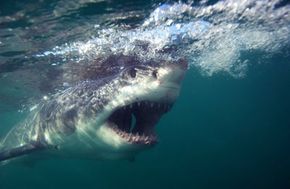Great White Sharks can be found in many parts of the world. See pictures of sharks.
Every summer millions of overworked minions all over the world take time off from the job, pack up the car and hit the beach for a nice, relaxing family vacation. A little saltwater, sunshine and sand in the toes are a healthy remedy for a stressed out and overextended workforce. Parents kick back while the kids build sand castles, toss the Frisbee and take a swim in the ocean. Singles roam the beach in search of. College kids party like it's 1999. It's all sun and fun until the lifeguard blows the whistle and yells the word that no beach comber ever wants to hear -- SHARK!
Advertisement
You might think that the likelihood of getting attacked by a shark is pretty great if you watch the news. The fact is, unprovoked shark attacks are extremely rare -- they just make for engrossing headlines. You're more likely to die from tangling with a bee, wasp or snake than a shark. You're also 30 times more likely to die from a lightning strike than a shark attack [source: International Shark Attack File]. But since filmmaker Steven Spielberg brought the movie "Jaws" to the big screen in 1975, beach-loving vacationers have had the possibility of a shark attack firmly lodged in the backs of their minds.
There's no doubt that sharks are one of the most feared creatures on Earth. But they are also one of the most sophisticated and enduring. The oldest shark fossils date from more than 300 million years ago, before the age of the dinosaurs. And a few existing shark species, such as the hornshark, have kept the same basic physical characteristics for more than 150 million years. Scientists attribute this remarkable longevity to the shark's superior physiological developments. Sharks are outfitted with several special characteristics that make them highly effective, both as hunters and survivors.
Sharks are a vital part of the ocean's ecosystem and sadly, overfishing has left many species of shark in danger of extinction. The International Union for Conservation of Nature (IUCN) lists three kinds of thresher sharks as vulnerable worldwide. The mako shark has been moved from near threatened to vulnerable and the scalloped hammerhead went from near threatened to endangered. These are only a few species that could be in trouble if fishing practices aren't more heavily regulated.









